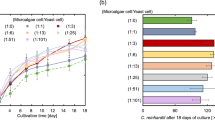Abstract
Suspension grown cells of Datura innoxia and Scopolia carniolica were tested for their glucosylation capacity and some factors affecting the efficiency of the reaction were studied.
Cells at the end of the exponential growth phase showed a high glucosylation capacity. Light conditions had little effect on the bioconversion reaction. For the substrates hydroquinone and p-hydroxybenzoic acid the bioconversions were concentration-dependent. Permeabilization with propanol diminished the bioconversion capacity. Depending on the substrate used, relatively large amounts of substrate and product could not be recovered. Tannic acid could partly prevent decomposition of the compounds. The bioconversion capacity of cultures with a low glucosylation capacity could be enhanced by addition of uridine diphosphate-glucose, indicating that the sugar donor is a critical factor. From six substrates the natural compounds hydroquinone, p-hydroxybenzoic acid and vanillin were glucosylated. No glucosides were detected from tyramin and two synthetic aminotetralines.
Similar content being viewed by others
Abbreviations
- 5HAT:
-
5-hydroxyaminotetralin
- NO437:
-
2-(N-propyl-N-2-thienylamino)-5-hydroxytetraline
- pHBA:
-
p-hydroxybenzoic acid
- UDP-glucose:
-
uridine diphosphate-glucose
References
Brodelius & Nilson K (1983) Permeabilization of immobilized plant cells, resulting in release of intracellularly stored products with preserved cell viability. Appl. Microbiol. Biotechnol. 17: 275–280
Catt JW (1981) Cell-wall mutants from higher plants: a new method using cell-wall enzymes. Phytochemistry 20: 2487–2488
Meyer R & Wagner FG (1985) Nucleotide pools in suspension-cultured cells of Datura innoxia I. Changes during growth of the batch culture. Planta 166: 439–445
Pras N, Wichers HJ, Bruins AP & Malingré ThM (1988) Bioconversion of para-substituted monophenolic compounds into correspondings catechols by alginate entrapped cells of Mucuna pruriens L. Plant Cell Tiss. Org. Cult. 13: 15–26
Suzuki T, Yoshioka T, Tabata M & Fujita Y (1987) Potential of Datura innoxia cell suspension cultures for glucosylating hydroquinone. Plant Cell Rep. 6: 275–278
Tabata M, Ikeda F, Hiraoka N & Konoshima M (1976) Glucosylation of phenolic compounds by Datura innoxia suspension cultures. Phytochemistry 15: 1225–1229
Tabata M, Ikeda F, Hiraoka N & Konoshima M (1976) Glucosylation of phenolic compounds by Datura innoxia suspension cultures. Phytochemistry 15: 1225–1229
Tabata M, Umetani Y, Ooya M & Tanaka S (1988) Glucosylation of phenolic compounds by plant cell cultures. Phytochemistry 27: 809–813
Tanaka S, Hayakawa K, Umetani Y & Tabata M (1990) Glucosylation of isomeric hydrobenzoic acids by cell suspension cultures of Mallotus japonicus. Phytochemistry 29: 1555–1558
Van Uden W, Pras N & Malingré ThM (1990) The accumulation of podophyllotoxin-β-D-glucoside by cell suspension cultures derived from the conifer Callitris drummondii. Plant Cell Rep. 9: 257–260
Author information
Authors and Affiliations
Rights and permissions
About this article
Cite this article
Scholten, H.J., Schans, M.J. & Somhorst, I.P.M. Factors affecting the glucosylation capacity of cell cultures of Datura innoxia and Scopolia carniolica for monophenolic compounds. Plant Cell Tiss Organ Cult 26, 173–178 (1991). https://doi.org/10.1007/BF00039940
Received:
Accepted:
Issue Date:
DOI: https://doi.org/10.1007/BF00039940




